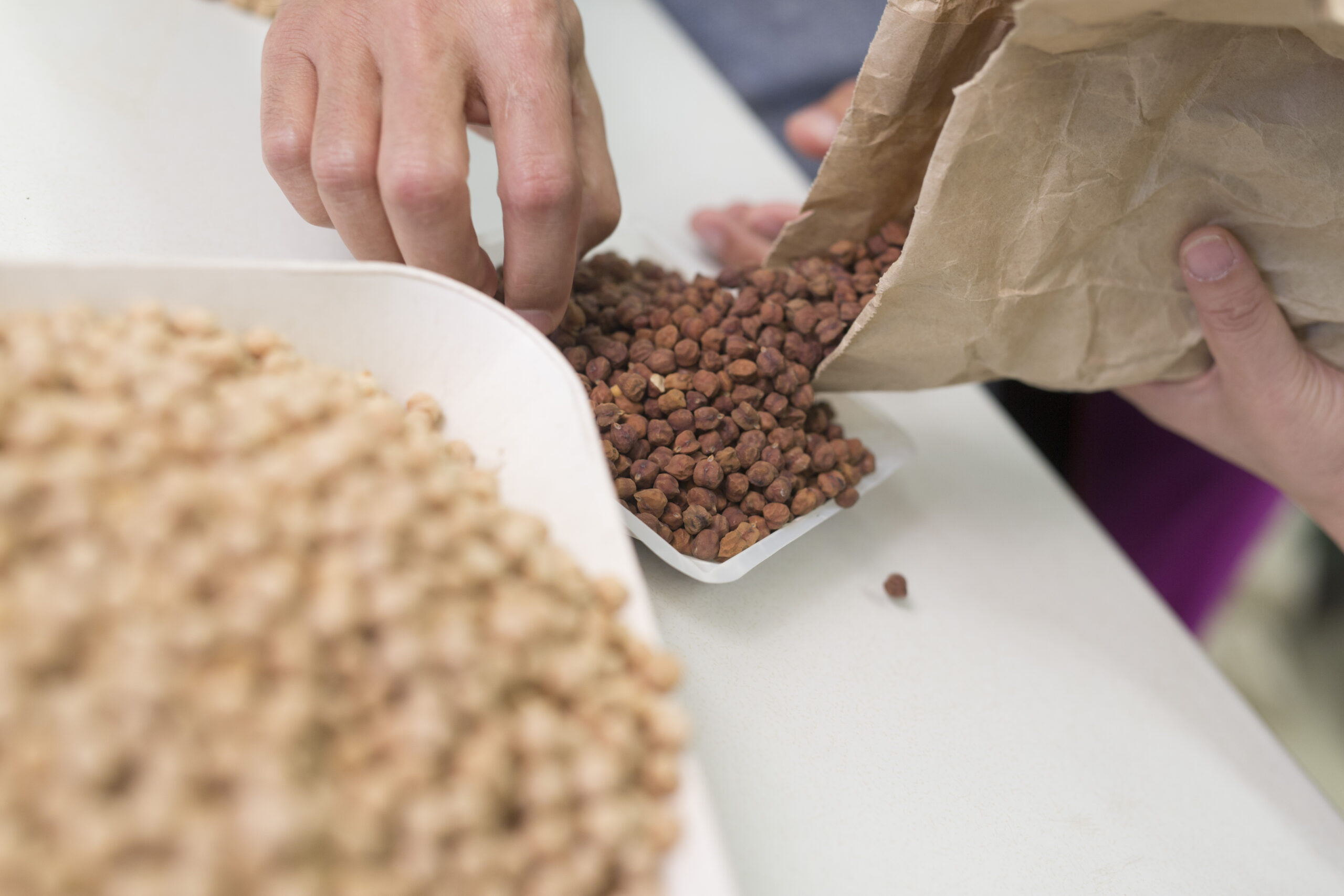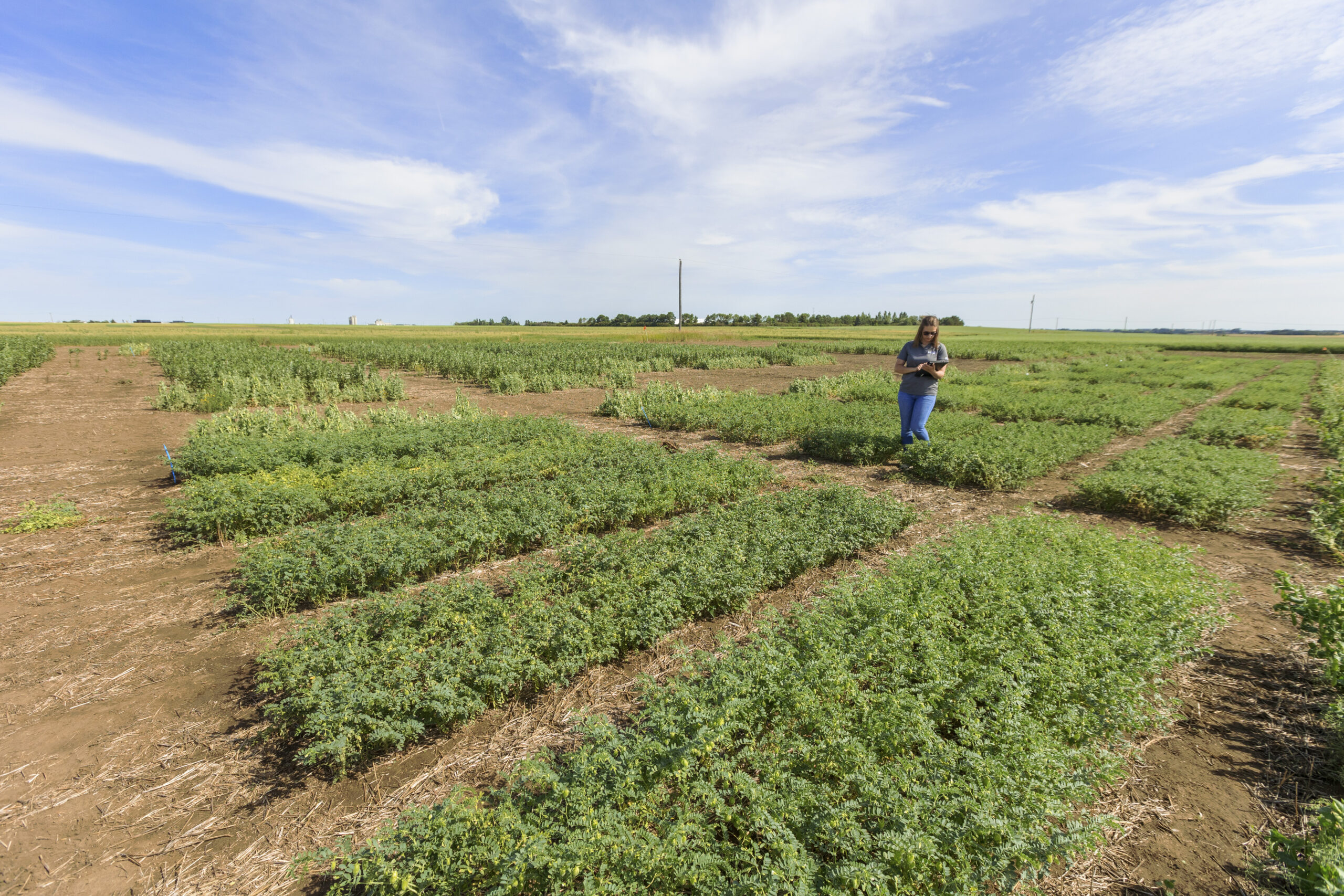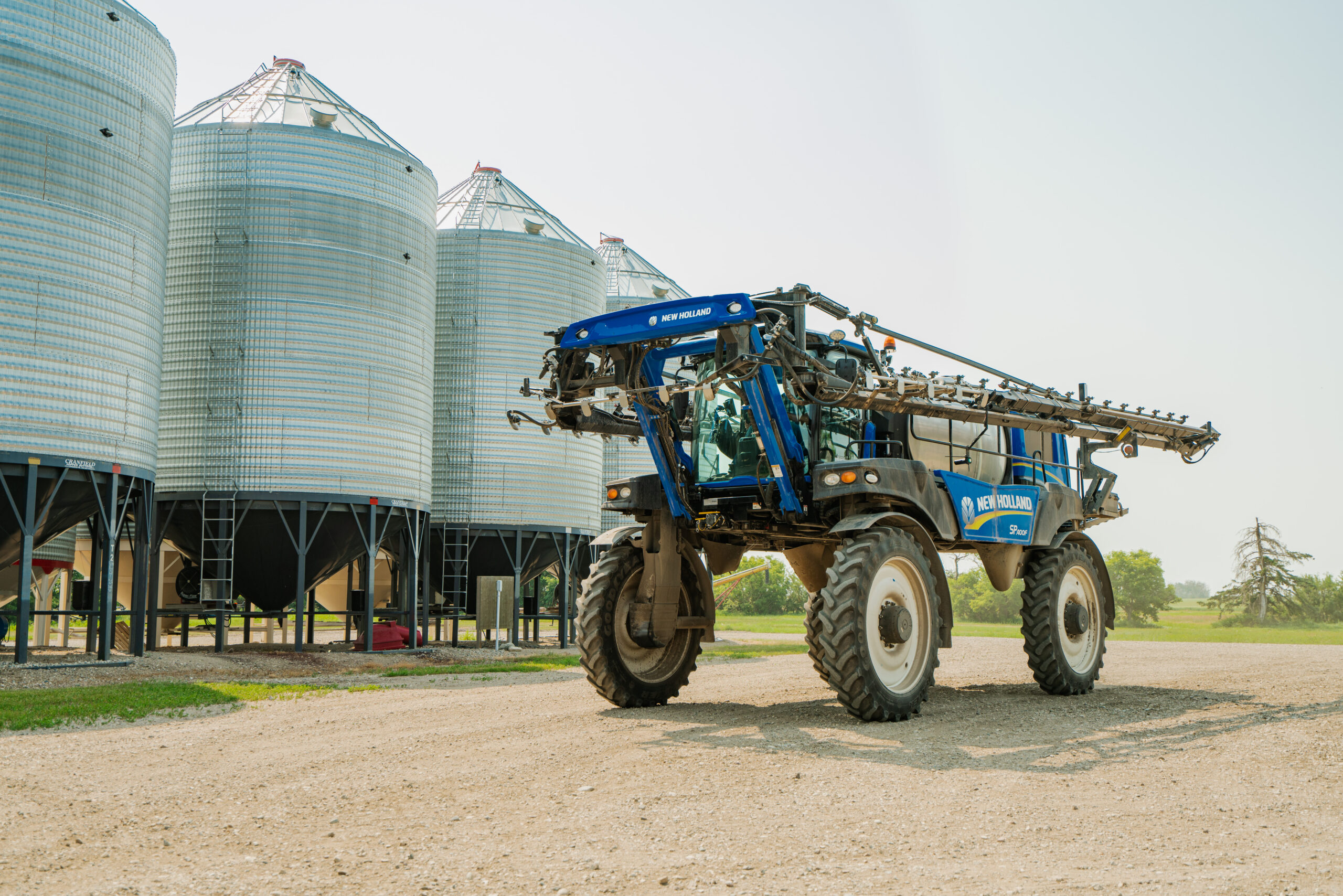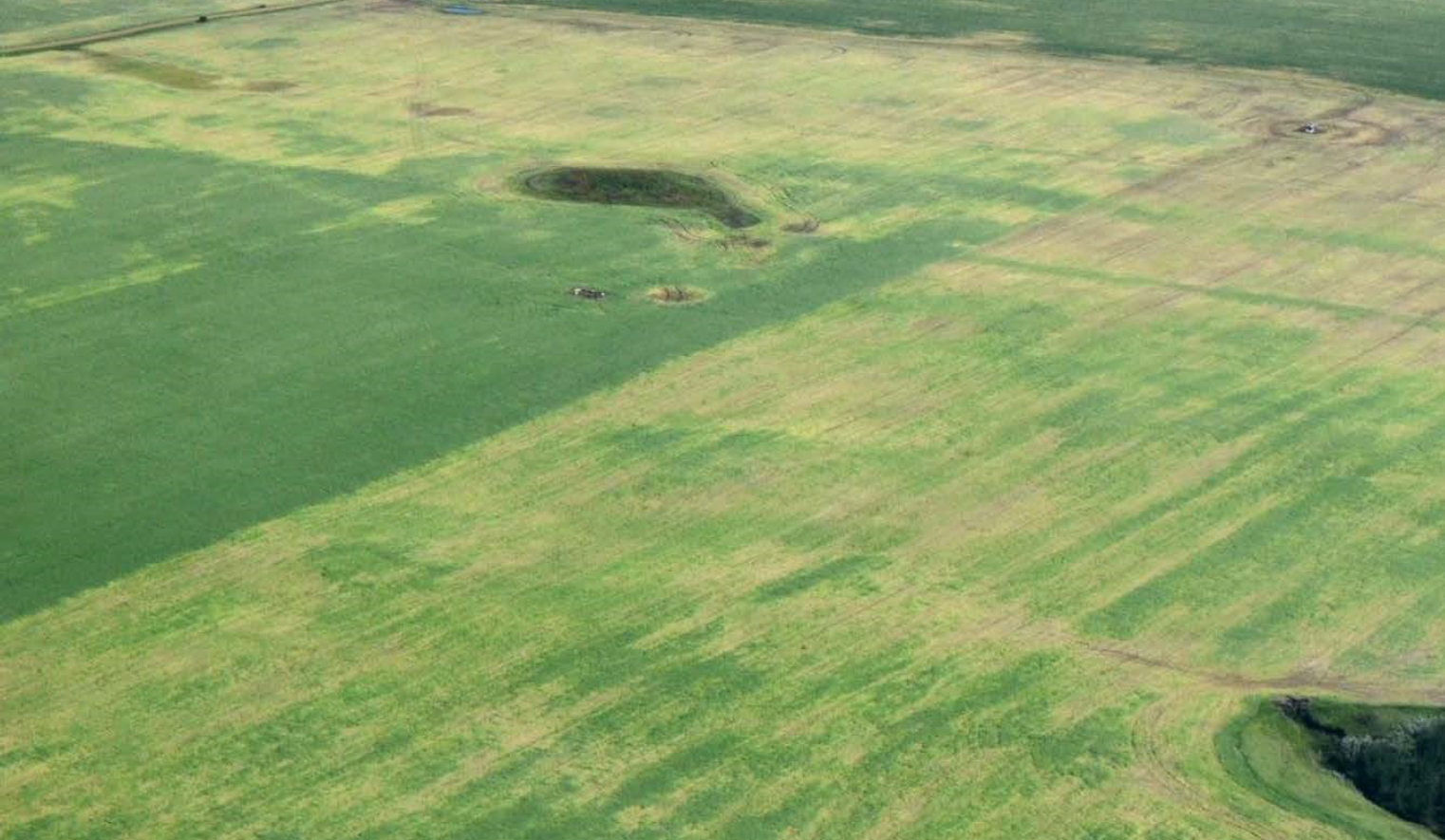Each year, the Saskatchewan pulse and cereal commissions partner with commercial seed testing laboratories to complete an annual survey of seed-borne pathogens measured on seeds grown in Saskatchewan during the previous season. All labs that offer seed testing services to Saskatchewan growers are invited to participate in the annual survey with anonymous reporting of results amalgamated by crop district from all participating labs.
Interim seed quality data, collected from the time of harvest to the end of December, are summarized and communicated to growers, agronomists, researchers, and industry during the winter months, ahead of the next crop season. These interim results provide insights into seed quality trends and identify potential hotspots for seed-borne pathogens across the province. A final summary of results, including data from seed samples analyzed after the interim results, is reported at the end of May. This final summary is submitted for publication in the Canadian Phytopathological Society Canadian Plant Disease Surveys. This publication of the provincial survey provides a record of seed-borne pathogen trends in pulse and cereal crops and allows for continued tracking of diseases over time. This document is intended to summarize the results to provide trends in the province and crop districts. These results should not be used in the absence of testing and extra caution should be used when interpreting results with very few samples. Sample size is indicated for each crop district on the maps.
Acknowledgments
The provincial seed survey would not be possible without the participation of 20/20 Seed Labs Inc., Discovery Seed Labs, and Prairie Diagnostic Seed Labs. Lendon Seed Labs also participates in the survey but shares final results only. Thank you to all lab partners for their continued effort and support of this project. Brian Olson, independent contractor, is also gratefully acknowledged for his coordination of the seed quality survey and summarization of results. A special thanks is also extended to Dr. Randy Kutcher and Dr. Sabine Banniza from the University of Saskatchewan for their external review and pathology expertise. External review efforts of Dr. Alireza Akhavan, Provincial Plant Disease Specialist and Dale Risula, Provincial Pulses, Forages, and Specialty Crops Specialist, of the Saskatchewan Ministry of Agriculture (SMA) are also recognized with an extra note of appreciation to Dr. Alireza Akhavan and the SMA Geomatics team for creating the seed-borne pathogen maps by crop district.

Germination Results
Percent germination levels were documented during the 2023 provincial seed survey with interim results showing a slight improvement of germination levels across most crops from reported levels in 2022. High numbers of seed lots harvested in 2021, particularly field pea, were reported to have below acceptable levels of germination and steady increases in germination of seed lots harvested in 2022 and 2023 have been seen. Mean germination of all crop types tested was 94.0%.
Although germination levels look quite favourable across all provincial crop districts and all crop types, testing of individual seed lots is still recommended prior to seeding in the spring of 2024.
Table 1. Average percent germination of Saskatchewan pulse and cereal seed samples analyzed by commercial labs as of December 28, 2023.
| Type | Crop | Number of Samples | Mean Germination (%) |
| Pulses | Lentils | 351 | 96.1 |
| Peas | 277 | 91.0 | |
| Chickpeas | 55 | 92.6 | |
| Cereals | Barley | 176 | 96.0 |
| Durum | 267 | 93.9 | |
| Oats | 42 | 95.0 | |
| Wheat | 629 | 93.4 |

Source: Saskatchewan Ministry of Agriculture
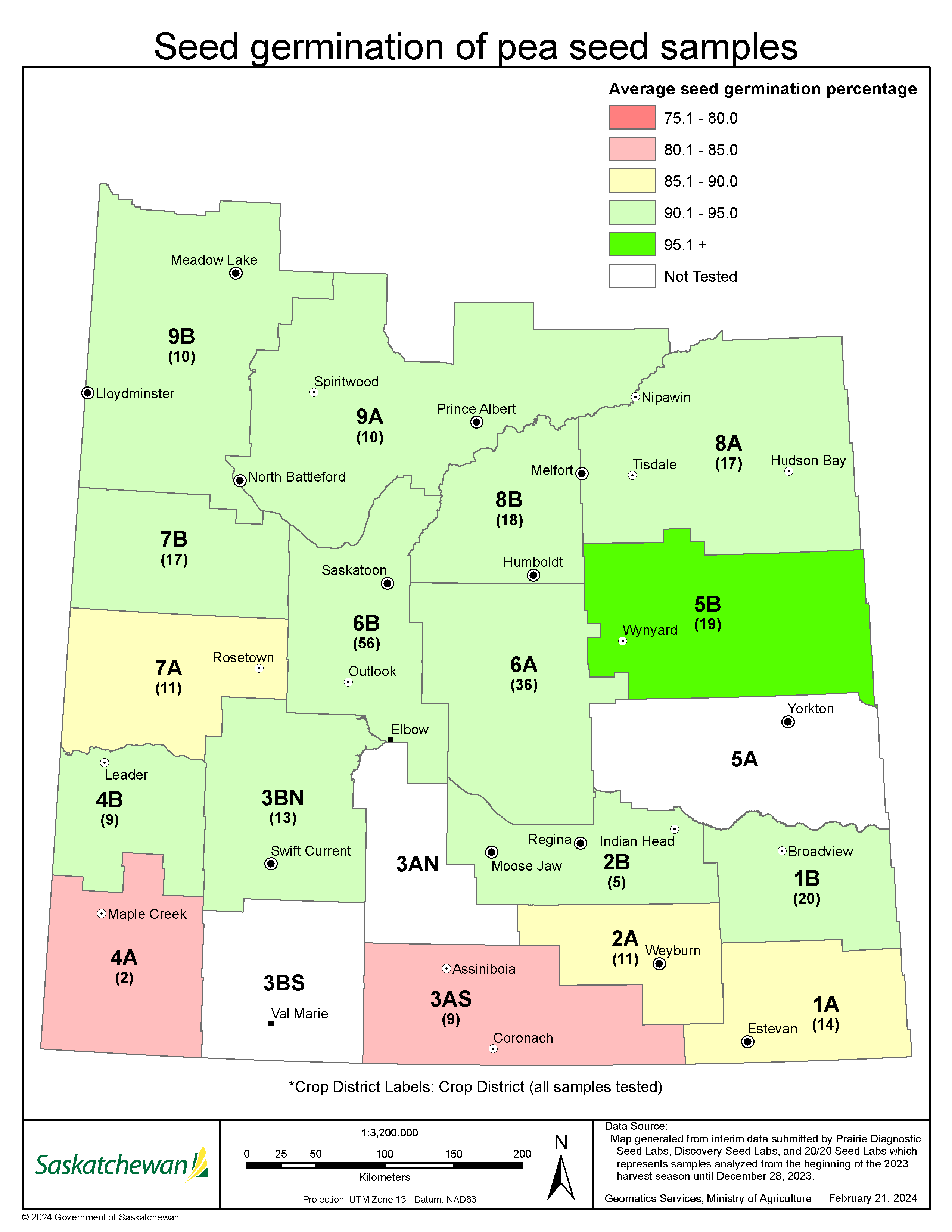
Source: Saskatchewan Ministry of Agriculture
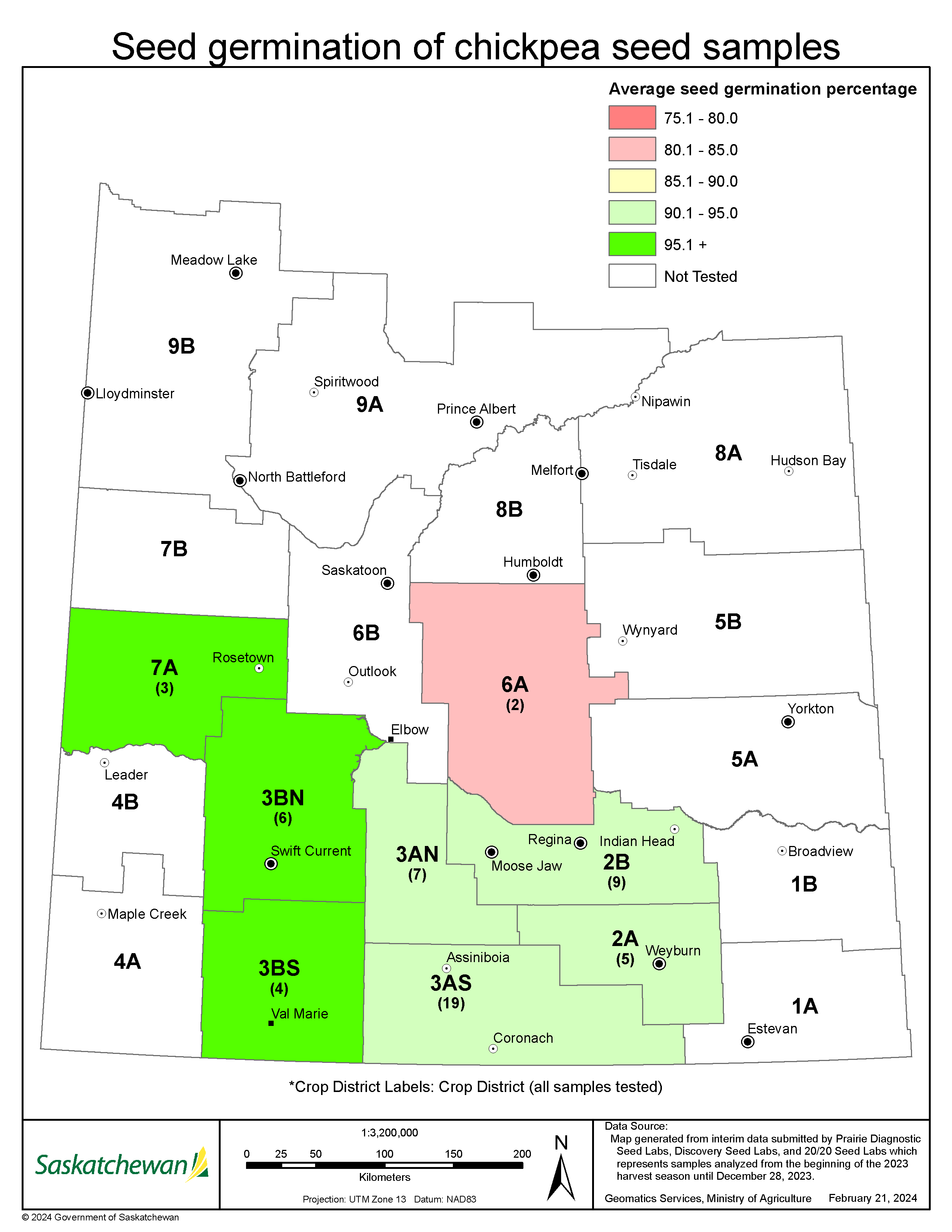
Source: Saskatchewan Ministry of Agriculture

Source: Saskatchewan Ministry of Agriculture
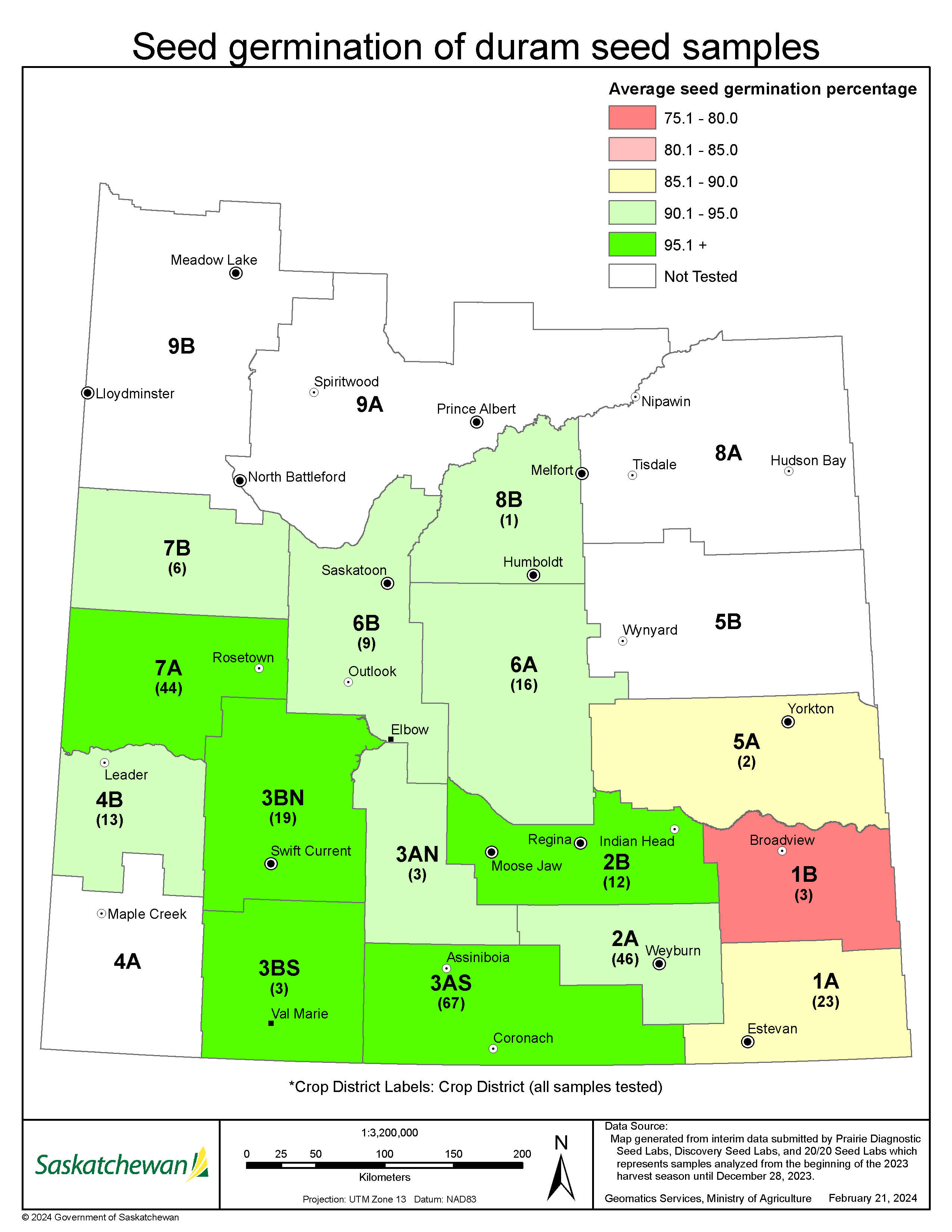
Source: Saskatchewan Ministry of Agriculture
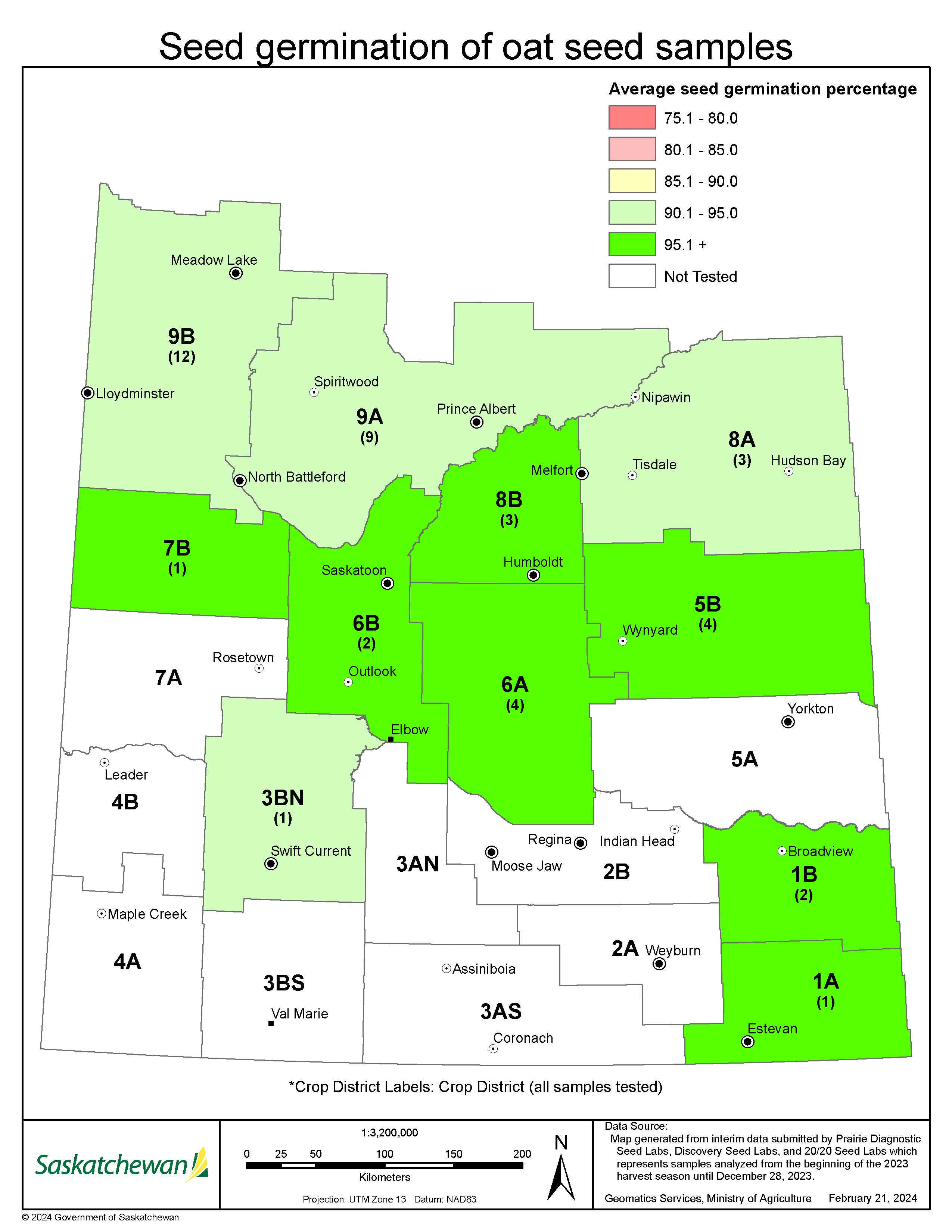
Source: Saskatchewan Ministry of Agriculture
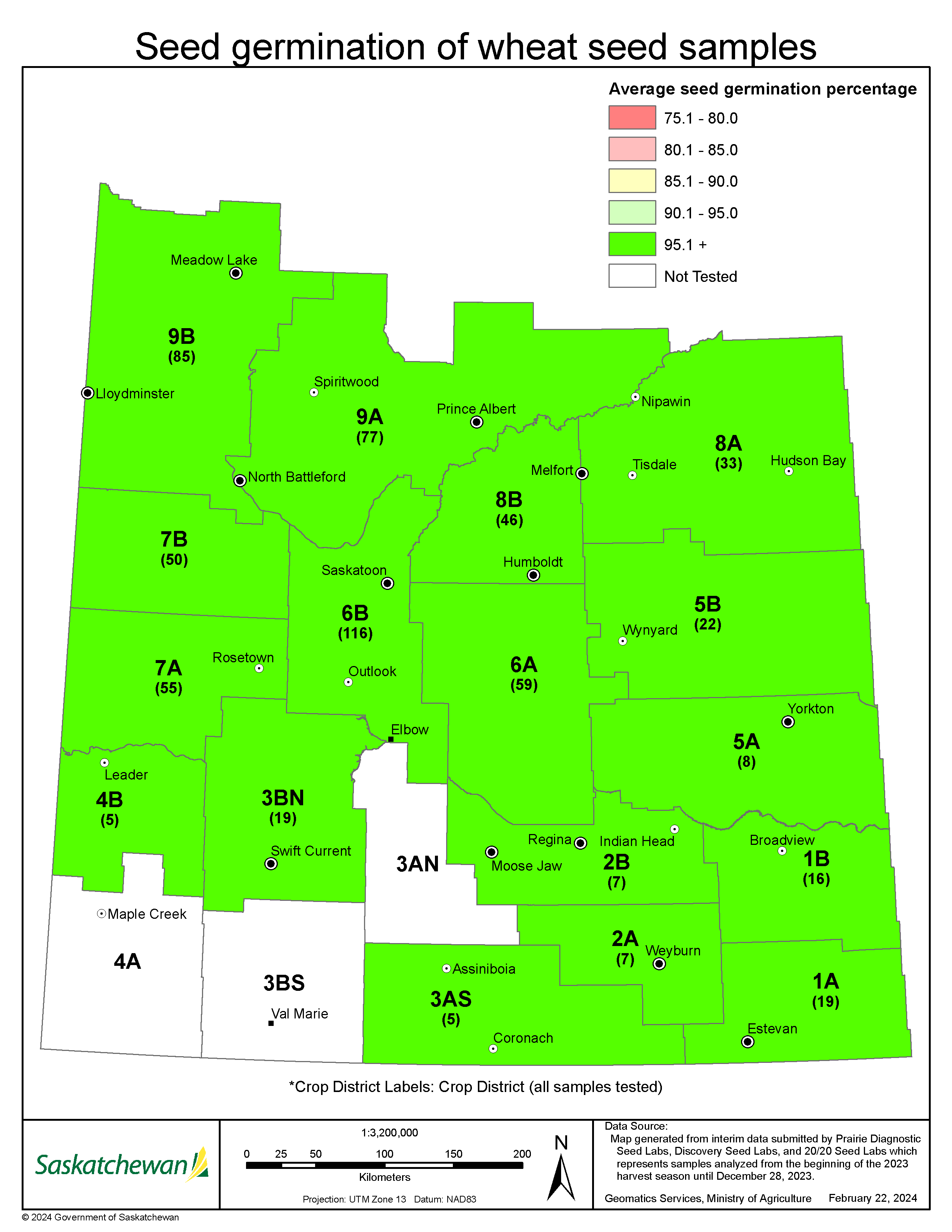
Source: Saskatchewan Ministry of Agriculture
Pulse Pathogen Results
The interim results of commercial plate tests for seed-borne pathogens of lentil, field pea, and chickpea samples reveal a relatively high number of pathogen-free seed samples from across the province. Results to-date suggest a strong overall decrease in mean infection levels of seed produced during the 2023 growing season compared to results from 2022.
- Greater than 95% of lentil samples were free of seed-borne pathogens; samples that did have detectable levels of Ascochyta, Anthracnose, or Botrytis had a mean infection level that did not exceed 0.2%.
- Seed-borne Anthracnose levels in lentils decreased in 2023 by over 12% and mean infection dropped by 1.0% from 2022 levels.
- Seed-borne Botrytis was detected on less than 2% of lentil and less than 1% of field pea samples.
- Seed-borne Ascochyta was detected on 44.8% of field pea samples but mean infection levels (1.1%) were well below critical threshold levels.
- 12.7% of chickpea samples had detectable levels of seed-borne Ascochyta in 2023, a decrease of over 25% from 2022 levels (37.8%). On average, the level of infection dropped by 1.1% from 2022 levels to 0.3% in 2023, which is the critical threshold of 0.3%.
- Seed-borne Sclerotinia and Botrytis was not detected on any chickpea samples.
Distribution of submitted samples and crop districts reporting seed-borne pathogens varies across the province. Although the maps created by the Saskatchewan Ministry of Agriculture can help identify areas of lower risk of seed-borne disease, testing of individual seed lots is still recommended.
Table 2. Average percent of pathogen-free pulse seed samples and average infection levels measured in samples with disease analyzed as of December 28, 2023.
| Crop | Pathogen | Number of Samples | Pathogen-free samples | Mean infection1 |
| (%) | ||||
| Lentils | Ascochyta | 349 | 95.7 | 0.2 |
| Anthracnose | 348 | 98.0 | 0.1 | |
| Botrytis | 348 | 98.6 | 0.1 | |
| Sclerotinia | 348 | 99.4 | 0.05 | |
| Field Peas | Ascochyta | 268 | 55.2 | 1.1 |
| Botrytis | 266 | 99.6 | 0.1 | |
| Sclerotinia | 266 | 98.9 | 0.1 | |
| Chickpeas | Ascochyta | 55 | 87.3 | 0.3 |
| Botrytis | 55 | 100 | 0.0 | |
| Sclerotinia | 55 | 100 | 0.0 | |
1Mean infection level of samples with disease

Source: Saskatchewan Ministry of Agriculture

Source: Saskatchewan Ministry of Agriculture
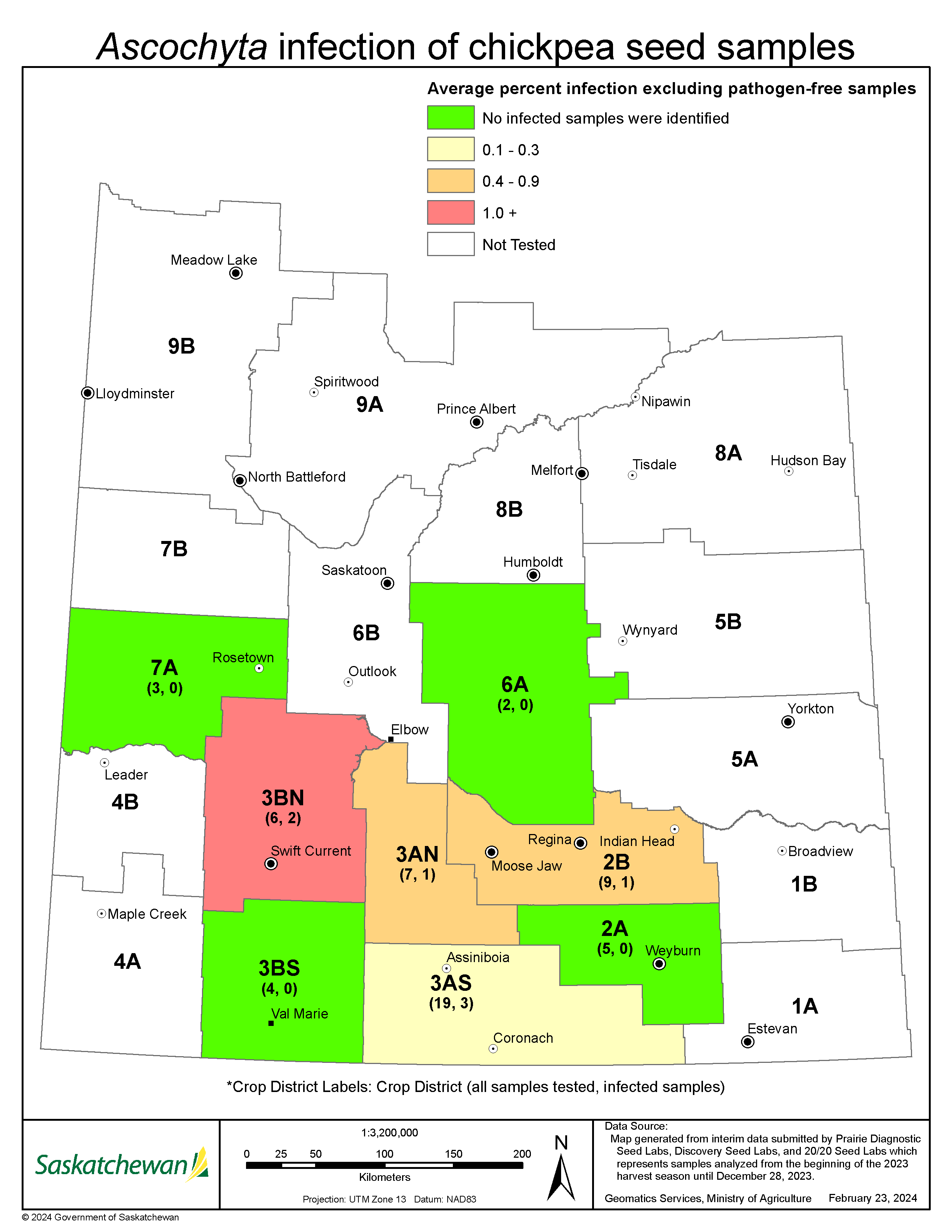
Source: Saskatchewan Ministry of Agriculture
Cereal Pathogen Results
The interim results of commercial plate tests for seed-borne fusarium pathogens reveal very low mean infection levels in barley, durum, oat, and wheat samples tested as of December 28, 2023. The percentages of total Fusarium spp. and F. graminearum-free samples are trending higher with lower mean infection levels across all cereal samples relative to the previous season.
- F.graminearum was detected on less than 13.0% of durum, oat and wheat samples, but was identified on 23.5% of barley samples; mean infection levels were 0.9% or lower for all cereal samples.
- The highest percentage of total Fusarium spp.-free samples were in durum (59.2%), followed by wheat (34.2%); durum and wheat had the lowest mean infection levels of total Fusarium spp., 1.3% and 1.8%, respectively.
- Most oat samples (82.5%) had detectable levels of total Fusarium spp. with a 2023 mean infection level of 3.7% which is lower than that measured in 2022 (5.9%).
- 74.1% of barley samples reported a detectable level of total Fusarium spp.; however, the mean infection level to date is 1.3%, which is lower than in 2022 (3.8%).
Table 3. Average percent of pathogen-free cereal seed samples and average infection levels measured in samples with disease analyzed as of December 28, 2023.
| Crop | Total Fusarium | Fusarium graminearum | ||||
| Pathogen-free samples | Mean infection1 | Number of Samples | Pathogen-free samples | Mean infection1 | Number of Samples | |
| (%) | ||||||
| Barley | 25.9 | 2.5 | 174 | 76.5 | 0.9 | 170 |
| Durum | 59.2 | 1.3 | 267 | 90.6 | 0.5 | 202 |
| Oats | 17.5 | 3.7 | 40 | 95.1 | 0.1 | 41 |
| Wheat | 34.2 | 1.8 | 591 | 87.1 | 0.7 | 621 |
1Mean infection level of samples with disease
Despite overall low levels of Fusarium-infected cereal seed lots being reported in interim results, seed quality does vary by crop districts as detailed by maps created by the Saskatchewan Ministry of Agriculture and it is recommended that seed lots should be tested on an individual basis.
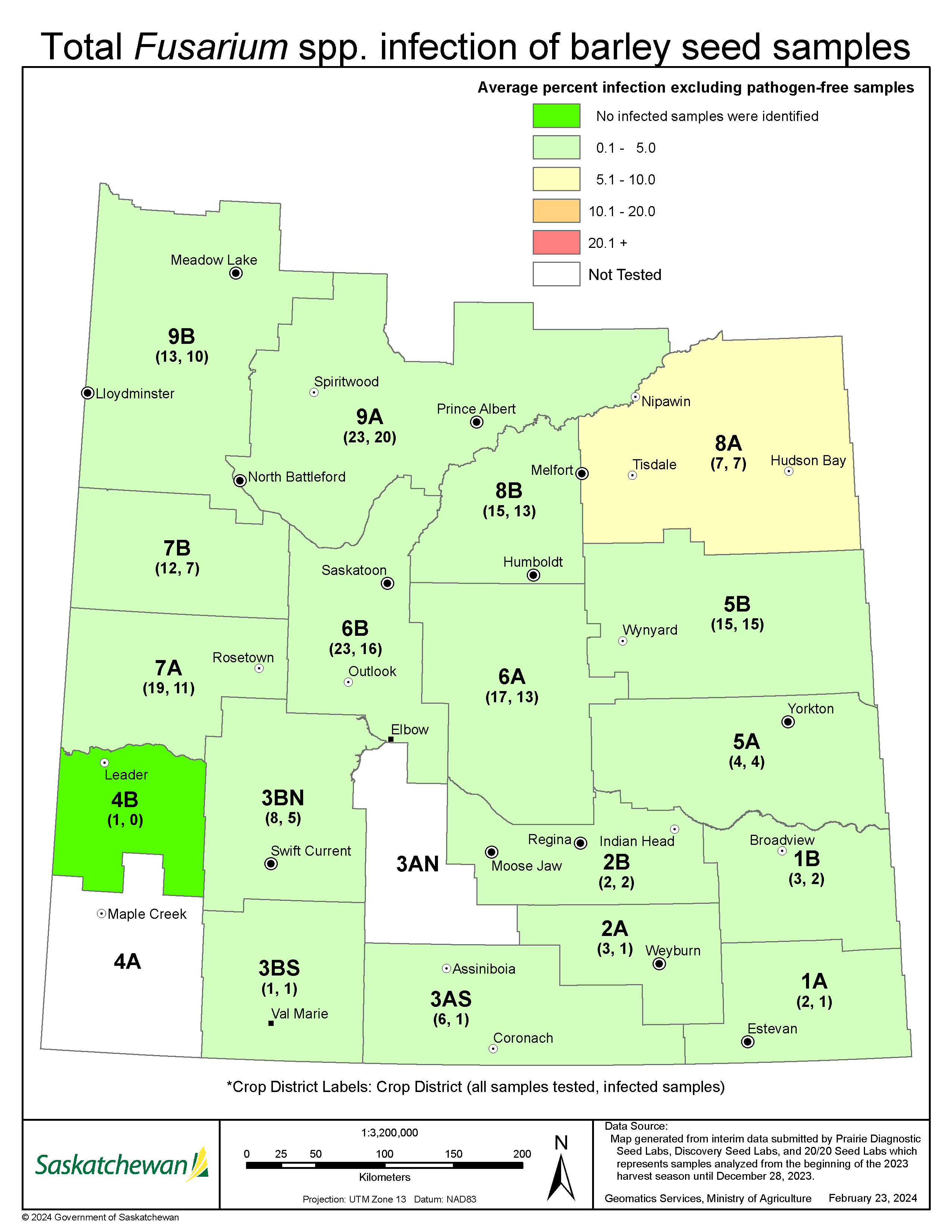
Fusarium in Barley.
Source: Saskatchewan Ministry of Agriculture

Fusarium in Durum.
Source: Saskatchewan Ministry of Agriculture

Fusarium in Oat.
Source: Saskatchewan Ministry of Agriculture
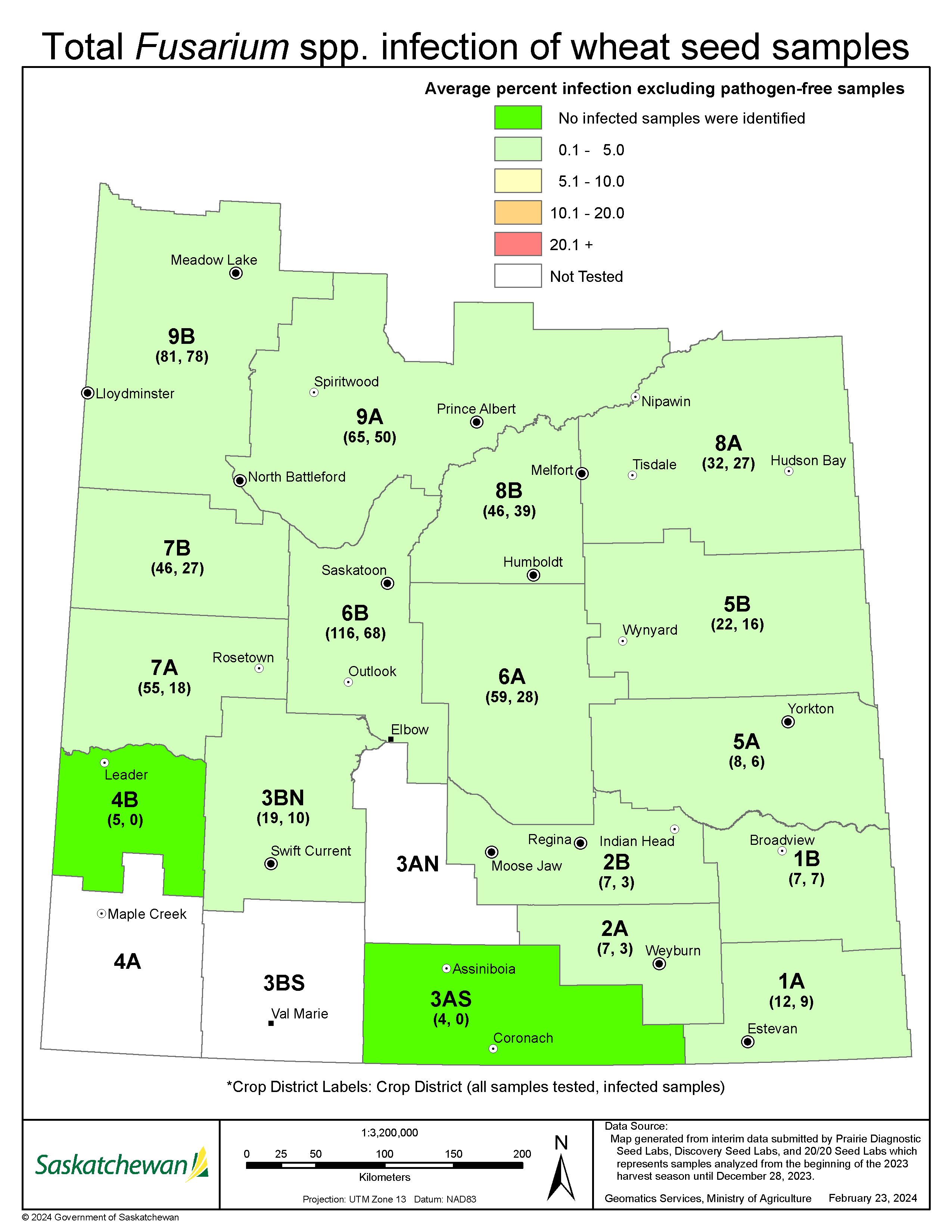
Fusarium in Wheat.
Source: Saskatchewan Ministry of Agriculture



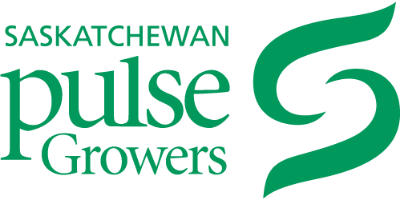

Published March 2024
